by Ivary & Paola | Feb 8, 2020 | 4th/5th Grade News
History & Geography
This week we continued learning about the Reformation. Our objectives were:
- understand who Martin Luther was, what reforms he wanted and why
- understand the role of the Catholic Church during the Reformation
- compare the reforms made to the Catholic church and the scientific community
- learn about Copernicus’ and Galileo’s role in the Reformation
Mathematics
This week we continued working with Ratios. Our objectives were:
- compare three quantities with ratios
- find the simplest form of 3 quantity ratios
- find equivalent 3 quantity ratios
- continue using CUBES to complete word problems
We also had our first Math Meeting this week! Math Meetings are times for our students to review topics already covered in class. They will reinforce past chapters and fill any gaps in their knowledge. Students will meet with either me or Ms.Laura once a week for these Math Meetings.
Lectura
This week we finished reading the expository text: El viento en acción. Students used evidence from the text to provide answers to comprehension questions as well as express their personal opinions about renewable and non-renewable energy. We had a fantastic discussion! Our objectives included:
- Apply reading comprehension skills and strategies as they read the selection: summarizing, clarifying, asking questions,
- Identify and provide examples of cause and effect situations.
- Understand the spelling patterns of words with z.
- Understand the use of possessive adjectives and possessive pronouns in context.
- Learn how to paraphrase text.
- Use the information gathered, accurately organize it into categories.
- Cross-check different sources of information.
Objectives for persuasive report:
- Gather ideas for their persuasive report.
- Organize their ideas using an outline.
- Draft their persuasive reports.
- Apply writing conventions.
Ciencias
What happens when compost worms interact with organic matter?
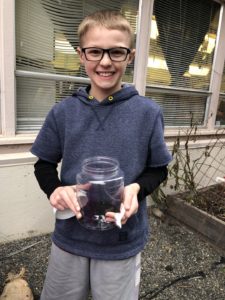
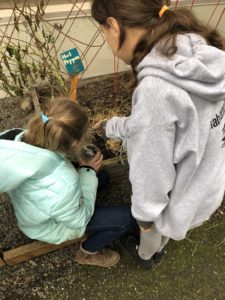
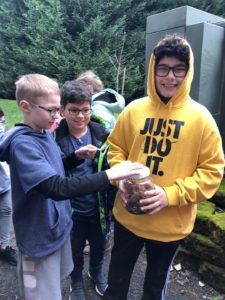
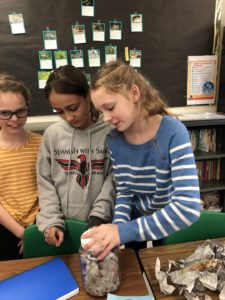

Working in groups, students set up a redworm habitat system to study detritivores. They recorded what organic materials went into the habitat with redworms. Students made predictions about what changes they will observe in our habitats over time. We will be observing and recording changes in the worm jar over 1–2 months.
- A system is a collection of interacting parts, ideas, and/or procedures that together define a physical entity or process.
- A subsystem is a small system that is inside a larger system.
- Earth can be described as the interaction of four earth systems: the rocky part (the geosphere), the atmosphere, the water (hydrosphere), and the complexity of living organisms (the biosphere).
- Food webs are subsystems within ecosystems. They describe the transfer of matter and energy within the system.
This week students took home a science book. They are expected to read the book multiple times at home and come prepared on Monday to participate in a book discussion/activity.
by Ivary & Paola | Feb 1, 2020 | 4th/5th Grade News
History & Geography
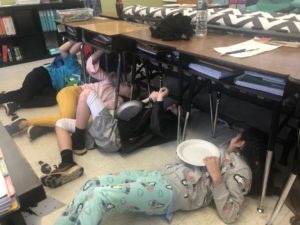 This week we finished out unit on the Renaissance and began our new unit The Reformation. Our objectives were:
This week we finished out unit on the Renaissance and began our new unit The Reformation. Our objectives were:
- find out what it might have felt like for Michelangelo to paint the Sistine Chapel by painting on our backs!
- complete the unit test as a class discussing each question to refresh our memories
- understand how the invention of the printing press affected Europe during the Renaissance and even changed our lives today
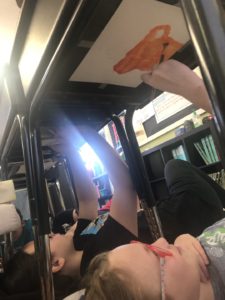 compare inventions from today (like the internet, telephones, and TV) to the printing press
compare inventions from today (like the internet, telephones, and TV) to the printing press
Mathematics
This week we continued working with Ratios. Our objectives were:
- use CUBES (circle, underline, box, evaluate and eliminate, solve and check) to complete word problems about ratios
- change ratios into fractions and fractions into ratios
Lectura
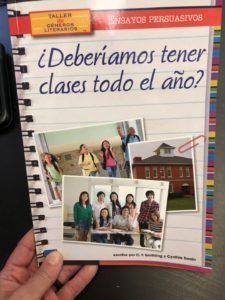
This week we started a new writing assignment: Ensayos persuasivos. To get familiar with the main objectives of this project, we have been conducting weekly class debates. Students have been learning about identifying the purpose and the audience for this project. This week we also talked about the elements and organization of a persuasive argument and the persuasive techniques such as word choice, repetition, emotional appeal, etc. Please take the time to talk to your child about this interesting piece, Deberíamos tener clases todo el ano?, and possibly have a family conversation around this topic! The objectives this week included:
- State a viewpoint and support it with facts, examples, explanations, and expert opinions.
- Establish purposes, audiences and the need for different genres.
- Accurately and meaningfully, identify and explain cause and effect situations that are directly connected to our argumentative writing studies.
- Understand the spelling patterns and semantics of homophones with c. Use these words in different contexts.
- Apply knowledge of the use of capitalization and proper punctuation.
- Understand the use of pronouns in context (demonstrative pronouns and possessive pronouns in particular)
- Learn how to paraphrase text.
- Using the information gathered, accurately organize it into categories.
- Cross-check different sources of information.
Ciencias
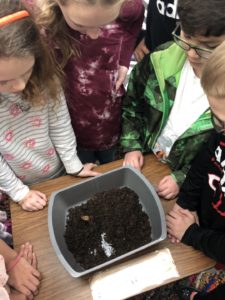
Students taking a closer look at our decomposers!
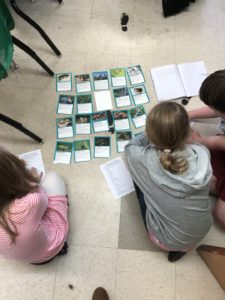 Students explored Earth as a system. Through video, we learned about four subsystems of planet Earth—the geosphere, atmosphere, hydrosphere, and biosphere. After watching the video, students answered questions and summarized the main concepts presented. We focused particularly on the biosphere and described ecosystems by looking at feeding relationships and energy transfers, described as food webs.
Students explored Earth as a system. Through video, we learned about four subsystems of planet Earth—the geosphere, atmosphere, hydrosphere, and biosphere. After watching the video, students answered questions and summarized the main concepts presented. We focused particularly on the biosphere and described ecosystems by looking at feeding relationships and energy transfers, described as food webs.
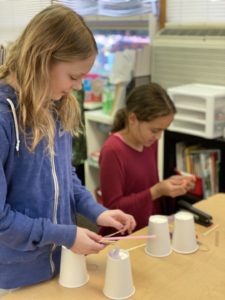 Character Education
Character Education
To continue our Perseverance theme, students were given a supply of materials and asked to invent a device that launched a pom pom into the air. There further it traveled the better! The idea was for them to make several attempts, to persevere through failed attempts and to continue to tweak their device to make it better.
Art with Ms. Kelly
Portraits
Every year I like to have the students work on a portrait project. The goals are:
- Observe shapes of faces
- Observe placement of eyes, nose, mouth
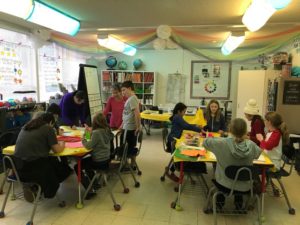
- Observe hair color and texture, and width of shoulders
- Look at reproductions of famous portraits such as Leonardo’s “Mona Lisa”, Paul Klee’s “Senecio,” and Picasso’s self portraits
The 4th and 5th Grade class worked on both a realistic portrait and also created a variety of abstract portraits using different materials including pipe cleaners and wire. Their wonderful realistic portraits are on the bulletin board at school, and we have several of their fun abstract portraits in their portfolios at school. Great job everyone!
In February we’re going to start a basket weaving project!
Music with Ms. Nadia
This month we experienced Modest Mussorgsky’s Pictures at an Exhibition. Originally a piano suite, this tribute to Viktor Hartmann’s collection of paintings was later turned into an orchestral symphony by Maurice Ravel. In other words, someone’s life inspired paintings, which inspired a piano suite, which inspired a symphony—which inspired us to create more art! We sketched our impressions of Gnomus, stretched to The Old Castle, walked around to the various Promenades, played Two Truths and a Lie to The Tuileries Gardens and Bydlo, drew portraits of Samuel Goldenberg and Schmulye (and compared our drawings to the real ones!), and both drew renderings of and danced an interpretive dance to Ballet of the Chickens in their Shells. In listening to both piano and orchestral versions, we determined that there are some songs we like better on piano and vis versa. Because he considered himself to be a realist, Mussorgsky’s music focused on how he perceived the world. This emotion translates different when played by multiple instruments vs a soloist. We learned about contrasts while comparing his busy and bustling movement Marketplace to his slow and sad Catacombs. Further contrasts can be heard when comparing the two different versions—the energetic keys to the shrill flutes and the slow dirge of the piano to the ominous horns. These contrasts can be seen in our everyday life, too! Life is fast and slow, happy and sad, light and dark—not just one thing all the time. And thus, life which inspired art which inspired art which inspired art inspires us to make art and look at life a little differently.
We have also been honing our recorder skills through sight-reading. As a class, we know notes B A G E D (or bagel with a “d” instead of an “l”), and have learned songs such as Hot Cross Buns, Snow is Falling, and Why Does Boo Scare You? Students also learned the difference between staccato and legato, and can play quarter notes, eighth notes, half notes, and whole notes. Look at them go!
by Ivary & Paola | Jan 25, 2020 | 4th/5th Grade News
History & Geography
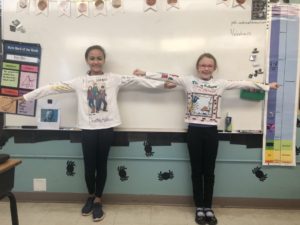
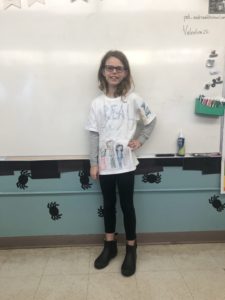
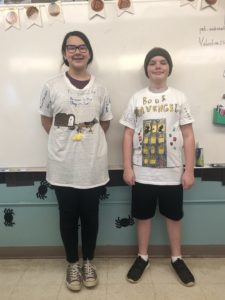 This week we continued learning about the Renaissance. Our objectives were:
This week we continued learning about the Renaissance. Our objectives were:
- review vocabulary from past chapters
- begin reading the chapter Two How-To Men
Next Monday we will be painting! We will use washable paint but please send your student in clothes that can get dirty just in case.
Mathematics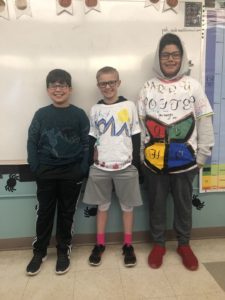
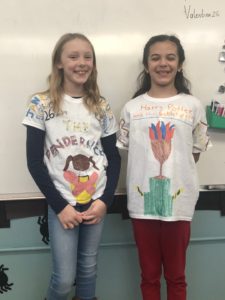
This week we began learning about Ratios. Our objectives were:
- use ratios to compare two things
- understand that you do not need the actual amount of items to create the ratio
- find the simplest ratio using the greatest common factor
- find missing terms using multiplication or division
Lectura
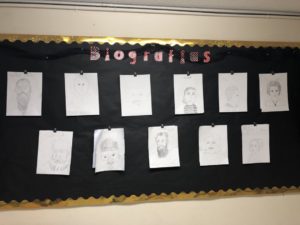
Congratulations to all our students for successfully completing our Biographies project. make sure you atop by our bulletin board to see their work.
Our objectives for this week in Spanish literacy included:
- Apply reading comprehension skills and strategies as they read the selection: summarizing, clarifying, asking questions, identifying cause and effect situations.
- Understand the spelling patterns of homophones with s.
- Understand the use of pronouns in context (demonstrative pronouns and possessive pronouns in particular)
- Learn how to paraphrase text.
- Using the information gathered, accurately organize it into categories.
- Cross-check different sources of information.
Ciencias
Students were introduced to a system as a collection of interacting parts that work together to make a whole or produce an action. They are presented with a common device and identify all the elements that go together to make that system. Students described other systems and subsystems.
- A system is a collection of interacting parts, ideas, and/or procedures that together define a physical entity or process.
- A subsystem is a small system that is inside a larger system.
- Earth can be described as the interaction of four earth systems: the rocky part (the geosphere), the atmosphere, the water (hydrosphere), and the complexity of living organisms (the biosphere).
- Food webs are subsystems within ecosystems. They describe the transfer of matter and energy within the system.
by Ivary & Paola | Jan 18, 2020 | 4th/5th Grade News
History & Geography
This week we continued to learn about the Renaissance. Our objectives were:
- Describe the great achievements of Michelangelo’s career.
- Understand Michelangelo’s importance to the European Renaissance.
- review vocabulary from chapters 4-6 by playing Quizlet
- examine the works of Leonardo da Vinci including The Last Supper, Mona Lisa, and The Vitruvian Man
- examine Donatello’s Saint George
Mathematics
This week we continued learning how to find the Area of Triangles. Our objectives were:
- demonstrate understanding of the area of a triangle formula by creating a poster
- review using the area of a triangle by completing a triangle maze
Lectura y Ciencias
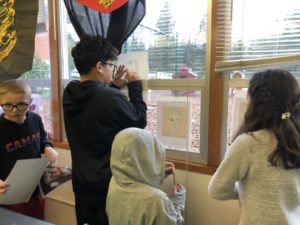 This week we continued to work on the same objectives as last week. During the last couple weeks, and following the writing process, students have been working on their science biography projects. We started this project reading a variety of biographies and using them as mentor texts to identify the key components of this genre. After that, students wrote a timeline to identify the stages in their characters life and their main contributions to their fields of study. The last part of this project was gather all this information put it into a essay format. We are happy to inform you all that we have finalized this project and will be presenting to the class next week January 23rd and 24th. We are looking forward to the presentations.
This week we continued to work on the same objectives as last week. During the last couple weeks, and following the writing process, students have been working on their science biography projects. We started this project reading a variety of biographies and using them as mentor texts to identify the key components of this genre. After that, students wrote a timeline to identify the stages in their characters life and their main contributions to their fields of study. The last part of this project was gather all this information put it into a essay format. We are happy to inform you all that we have finalized this project and will be presenting to the class next week January 23rd and 24th. We are looking forward to the presentations.
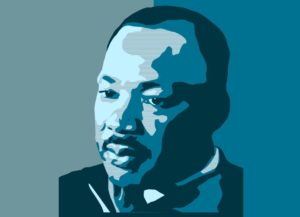
As part of our biography studies unit, students received the biography of Martin Luther King Jr. Please have your child read this piece over the weekend as part of their daily Spanish reading and be ready to discuss in class on Tuesday.
Character Education
To continue with our Perseverance theme this week we read The Girl With a Mind For Math, The Story of Raye Montague (Hidden Figure) by Julia Mosca.
After touring a German submarine in the early 1940s, young Raye set her sights on becoming an engineer. Little did she know sexism and racial inequality would challenge that dream every step of the way, even keeping her greatest career accomplishment a secrete for decades. Through it all, the gifted mathematician persisted — finally gaining her well-deserved title in history: a pioneer who changed the course of ship design forever.
This was a wonderful book to show how Raye Montague’s entire life was a lesson in perseverance. Being told she couldn’t be an engineer because of the color of her skin and because she was female did not stop her.
by Ivary & Paola | Jan 11, 2020 | 4th/5th Grade News
History & Geography
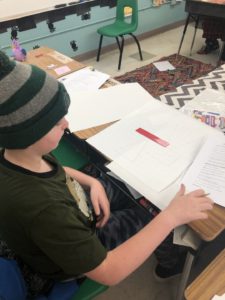 This week we continued to learn about the Renaissance. Our objectives were:
This week we continued to learn about the Renaissance. Our objectives were:
- review what we learned before break about Florence
- take a virtual tour of Venice
- create a Venn Diagram comparing Venice and Florence
- understand why Michelangelo Da Vinci was called “The Renaissance Man”
Mathematics
This week we began learning how to find the Area of Triangles. Our objectives were: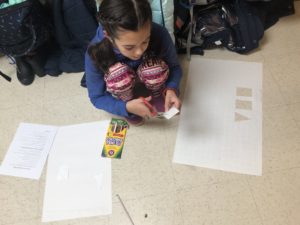
- complete test corrections and review how to multiply and divide fractions
- understand what the base of any polygon is
- practice finding the height of a triangle given the base
- begin creating a poster that explains why the area of a triangle is half of its rectangle
Lectura
This week we introduced our new unit: Energy in Action. The essential question for this unit is: How does energy affect our life? The development of this unit will be closely connected to our new science module, Living Systems starting the week of January 20th. During writing we continued with our biography project. We read the biography of one of our students favorite authors, J.K. Rowling, and used is as as example on our to outline their essays. Students did a great job using their resources (linea cronologica) to organize their biography paragraphs. We will be finishing the final details next week. We talked about finding a good date were students can present their biographies to the class, and invite families that would like to attend. I will make sure I will let you know as soon as we put a date on the calendar. Other objectives this week included:
- Establish purposes, audiences and the need for different genres.
- Apply reading comprehension skills and strategies such as asking questions, summarizing, visualizing, identify cause and effect situations.
- Understand the spelling patterns of homophones with v – b
- Apply knowledge of the use of capitalization and proper punctuation.
- Conjugate and understand how verbs are used in contexts, Present tense of regular verbs. Subject/ verb agreement.
- Using the information gathered, accurately organize it into categories.
- Cross-check different sources of information.
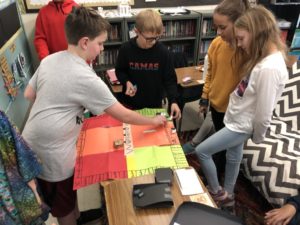
Dean presenting his spelling game to the class. It was so much fun!
Ciencias
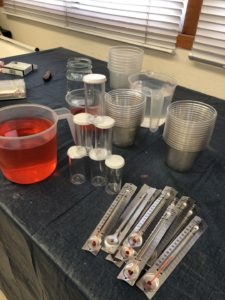 Heat, Earth Materials and Conduction
Heat, Earth Materials and Conduction
As a class we discussed the concept of energy. The sun is the major source of energy that heats Earth. The different energy transfer properties of earth materials (soil and water) can lead to uneven heating of the Earth’s surface. We also discussed the concept of radiation. After that, students observed an example of heat transfer by conduction: from hot water to a container of cold water. Students discussed the mechanisms by which energy transfers to and from the air: radiation and reradiation from Earth’s surface, and conduction between Earth’s surface and air particles.
Character Education
“Be like a postage stamp, stick to something until you get there!” ~Josh Billings
During the month of January we will be learning all about Perseverance. What does it mean?
- Staying with the task and not giving up.
- Showing commitment, pride and a positive attitude in completing tasks.
- Trying again and again and again.
- Being patient and willing to work hard.
Throughout the month we will be reading several great books, discussing them and then putting our perseverance to the test with some fun activities.
by Ivary & Paola | Dec 21, 2019 | 4th/5th Grade News

History & Geography
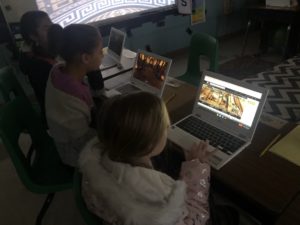
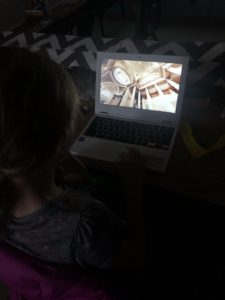 This week we continued learning about the Renaissance. Our objectives were:
This week we continued learning about the Renaissance. Our objectives were:
- Recognize the role various popes played as patrons of the arts during the Renaissance
- Describe the building of St. Peter’s Basilica
- Take a Virtual Field trip through the Pantheon and St. Peter’s Basilica
Mathematics
This week we continued to Multiply and Divide Fractions. Our objectives were:
- practice dividing a fraction by a fraction by completing real world problems
- review multiplying and dividing fractions by completing holiday crafts
- demonstrate understanding of the chapter by completing the chapter test
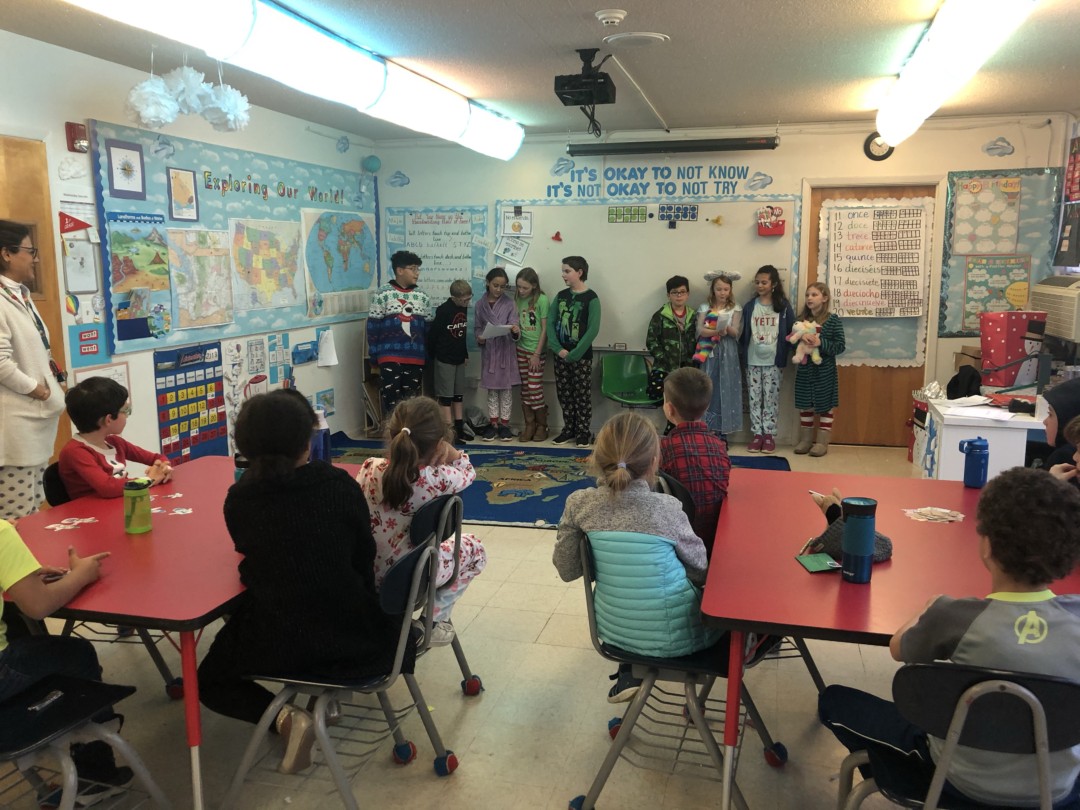
Specialists
Art with Ms. Kelly
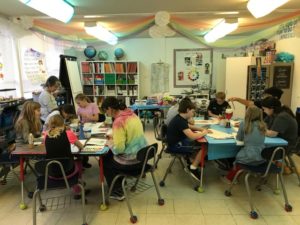 Nutcracker Drawings
Nutcracker Drawings
Grades 1 to 5 created some wonderful Nutcracker drawings and paintings this month! The goals were:
- Learn about Tchaikovsky’s Nutcracker Suite: the music, ballet and story
- Learn how to use folded paper guidelines and basic shapes to draw a nutcracker
- Add details, decorations and color, using markers, watercolors, and colored pencils
Each class did a wonderful job following directions and creating their own unique Nutcracker artwork!
Small Clay Sculptures
The students used Crayola Air-dry Clay and wire to create beautiful little sculptures. They painted these with acrylic paint and wrapped them in gift boxes for a lucky recipient!
Winter Trees with Snow
The students used copies of “Sleigh Ride” sheet music to cut out tree shapes, then added torn-paper evergreens, redbirds, and white tempera paint for snow.
Renaissance Art
We had a little time to compare and contrast “Madonna and Child” artwork from the Middle Ages and
the Renaissance. We’ll start on a Renaissance-style self portrait in January!
Thank you to Ms. Stacia and Ms. Laura for helping out each week in the 4/5 class!
Everyone have a wonderful holiday!
Music with Ms. Nadia
Tis the season for jingle bells, the Nutcracker, and Frozen 2! We have had a blast jingling along to our favorite holiday songs this month, especially Jingle Bells. Games like “Echo carols” and “Finish the song” kept us on our toes—and gave plenty of opportunity for Frozen 2 songs to sneak into the class! This past class was particularly special with a pop-up Christmas tree advent calendar! Students took turns opening a small door and decorating our 3D paper tree with an ornament—did I mention it was Harry Potter themed? There was one catch—each student had to first answer a question about something we’ve learned in music class so far. The order of questioning was determined by a game of “Musical Bear”, played to selections of Tchaikovsky’s The Nutcracker. We also played a hilarious game of “Rudolf the Red-Nose Madlibs”. Here is our version of the song:
John Cena the Blue-Nosed owl had a very tall leg.
And if you ever saw him, you would even say it fell!
All of the other ostriches used to laugh and call him Big Boy.
They never let Lucas join in any reindeer taekwondo.
Then one smelly Valentine’s Day eve, Riana came to say,
“John Cena with your fingers so flat, won’t you guide my dad tonight?”
Then how the hippogriffs loved him as shouted out with sadness!
John Cena the Blue-nosed Owl, you’ll go down in PE!
I’m enjoying this class’s creativity and enthusiasm! As the year is winding to a close, we are continuing learning the recorder. With this, students are improving their sight-reading skills! Songs we can play include Hot Cross Buns, Mary had a Little Lamb, and The Snow Song (which we sang as well). Students now know notes A, B, G, E, and D. With the new notes comes new challenges like skipping and finger placement. They can also play in various meters and are no longer caught off-guard by sneaky rests! Other highlights include dancing Zumba-style to Fire in my Soulby Walk off the Earth and All I want for Christmas is You by Mariah Carrey, playing a ukulele echo game, and singing about whales in the classic Down by the Bay.
Merry Christmas and a Musical New Year!
by Ivary & Paola | Dec 14, 2019 | 4th/5th Grade News
History & Geography
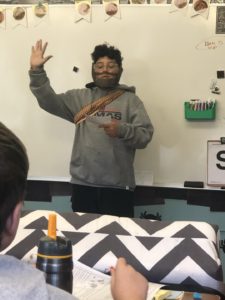 This week we continued to learn about The Renaissance. Our objectives were:
This week we continued to learn about The Renaissance. Our objectives were:
- understand linear perspective, found by Brunelleschi and Alberti, by creating a winter wonderland themed art piece
- discuss Botticelli’s The Birth of Venus and how it was inspired by Roman Mythology
- Understand Florentine society of the 1400s
- Understand the roles of members of the Medici family in Florence’s history
Mathematics
This week we continued to learn about Multiplying and Dividing Fractions. Our objectives were:
- Interpret division of a unit fraction by a non-zero whole number
- Solve real world problems involving multiplication of fractions and mixed numbers, by using visual fraction models or equations to represent the problem
- Solve real world problems involving division of unit fractions by non-zero whole numbers and division of whole numbers by unit fractions
Reminder that our T-Shirt Book Report is due January 10th!
Lectura
I was so very happy to share with our wonderful families all the work that our students have done this trimester during our conferences. Everybody should be very proud of their work!
It is hard to believe that our first trimester has come to an end. This week we spent our time working on our regular routines, as well as preparing for our end of the unit assessments. Students had a chance to present their creative spelling games. I am so impressed, not only by the hard work, creativity and effort they put into this project, but also by the way they incorporated the spelling concepts seen during this unit. After playing these games, students accomplished excellent results on their spelling assessment.
I will be travelling to Chile, this weekend, to visit my family and will be gone over winter break. Our class is so excited to welcome maestra Jackie as a guest teacher next week. We have some fun activities planned.
I would like to wish everyone a wonderful holiday season. I hope you all get to spend some precious family time, making exciting and fun memories together -because yes, family is indeed, the most important gift!
by Ivary & Paola | Dec 7, 2019 | 4th/5th Grade News
History & Geography
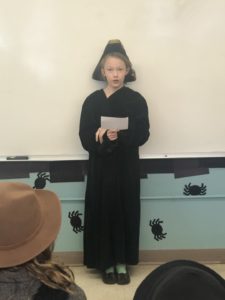
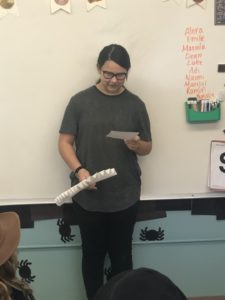
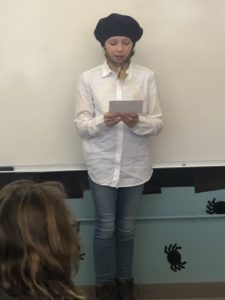
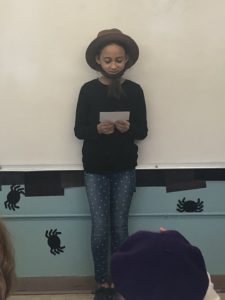
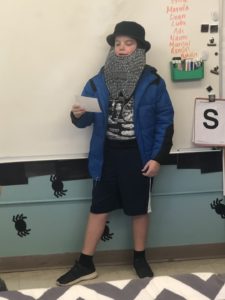
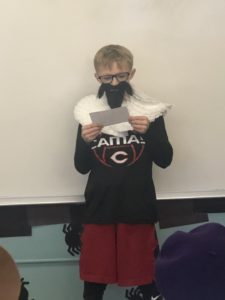
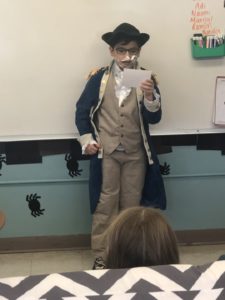
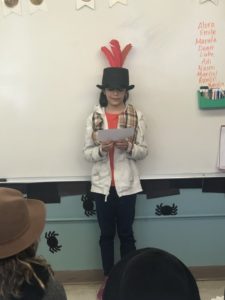
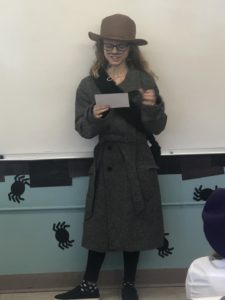
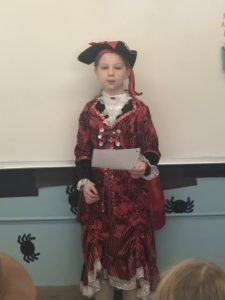
This week we began learning about the Renaissance. Our objectives were:
- complete our Age of Exploration unit by presenting our Explorer Reports
- compare and contrast the geography of 1300s Italy and present day Italy
- describe how and why the Renaissance began in Italy
- understand the differences between Medieval and Renaissance artists
Mathematics
This week we began learning about multiplying and dividing fractions. Our objectives were:
- finish out Algebra chapter by taking the chapter test
- understand how to multiply fractions “straight across”
- practice multiplying fractions within word problems
- understand how to multiply fractions with improper fractions
Lectura
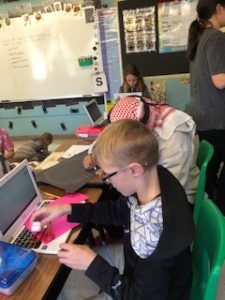
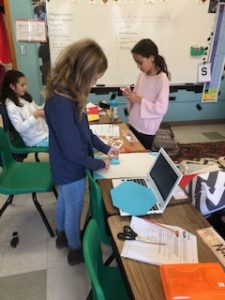
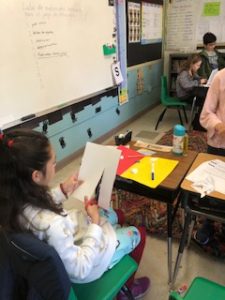
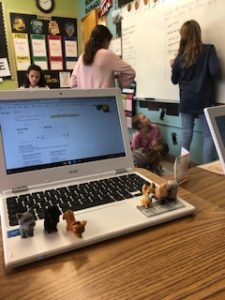
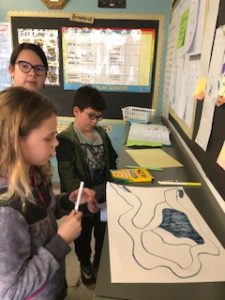
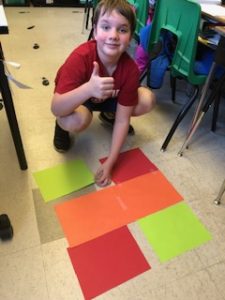
This week we started to wrap up our unit Nuestro rincón del universo. We finished reading the biography of Ellen Ochoa – she is such an inspirational scientist who opened the path for so many women in science. We also spent time reviewing the main objectives for this unit in ortografia and gramatica. Students took home their review packet. Please make sure they practice so they are ready for our end of the unit assessments next week. Students created spelling games to help them practice for our test too. They are amazing, as always! We will be having our reading and grammar test on Tuesday the 10th, and our spelling test on Thursday the 12th. Please let me know if you have any questions.
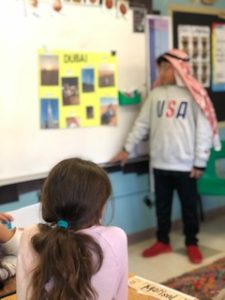
Ben did such a great job sharing with the class his amazing trip! What a wonderful experience!
Ciencias
What is the weather and how can it be described? How do meteorologists measure and record weather variables?
Students reviewed local weather reports and determined the variables that combine to produce the weather. They were introduced to weather instruments—a thermometer, compass,and wind vane. our class is using a digital weather station with a receiver outdoors to gather weather data, and develop a plan for acquiring daily data and sharing them with the class. We will continue to work on this next week.
Wednesday Specials
Character Education
This week we were so grateful to have Dr. Torres join us for a special lesson. We brainstormed emotions and read a lovely book “Moody Cow Meditates”. We then made our own Mind Jars. We needed to imagine that this jar is our mind. When we are in a calm state, we can think clearly, and make good decisions. We imagined that the glitter is anger, worry, fear, etc – when those feelings hit, we may feel unbalanced or our thoughts may feel jumbled up. Our mind is cloudy and we can’t think as clearly. If we are still, slow down and take deep breaths our thoughts can settle and we can see more clearly and make better decisions.
Music with Ms. Nadia
During the month of November, we learned all about the Orchestra! This magical group of musicians led by a conductor is composed of four sections: strings, wood winds, brass, and percussion. Each section has a distinct sound and special place on the stage. Within these sections, each instrument has its own range (set of notes its able to play). We learned that the bigger instruments (like tubas) have lower ranges, while tiny instruments (especially the piccolo!) have higher ranges. We had fun learning through games, posters, and whiteboard drawing activities. We also used a wonderful online resource which allowed us to listen to each instrument individually. Check it out at www.mydso.com/dso-kids/learn-and-listen/instruments !
Last month we also begun learning the recorder as a group, forming a “recorder choir”. Starting simple with notes G, A, and B, students are already able to sight-read music, follow rhythms, and play in harmony! Our student songs of the month led us to participate in You’re the Fire Zumba, Lemon Boy Stretches, and a Let Me Down Slowly rhythm stick game.
by Ivary & Paola | Nov 23, 2019 | 4th/5th Grade News
History & Geography
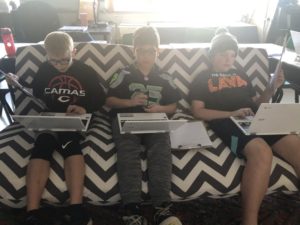 This
This 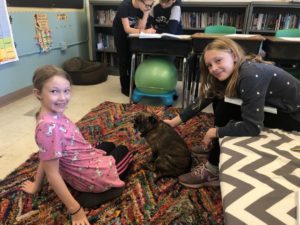 week we worked on our Explorer Presentations. Our objectives were:
week we worked on our Explorer Presentations. Our objectives were:
- collect information from our textbooks about our explorers
- use the internet to collect more information about our explorers
- combine information in a 1-2min speech
- practice giving and timing your speech
We will present our explorer projects on Friday December 6th at the beginning of class. We would love to have you there!
Mathematics
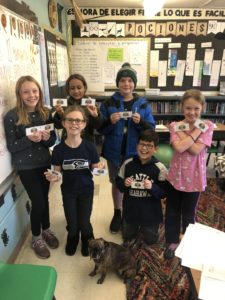
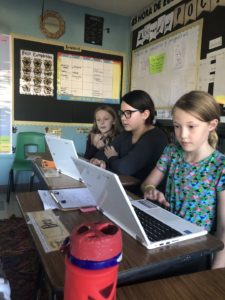 This week we worked with Algebra. Our objectives were:
This week we worked with Algebra. Our objectives were:
- understand and apply the vocabulary variable, algebraic expression, inequality, solve, and evaluate
- write algebraic expressions from story problems
- solve for the variable when it is one side of the equation or on both
- solve inequalities that use variables
- Complete a Thanksgiving Long Division review Escape Room
Lectura
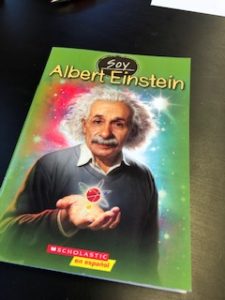 Literacy Weekly Concept/Genres: Expository – Biographies
Literacy Weekly Concept/Genres: Expository – Biographies
This week we started working on our new writing assignment: Biographies. We reviewed the characteristics of this expository genre. Students will be selecting and writing a biography about a scientist. We also started reading the biography of Ellen Ochoa. We will continue to work on this project after we come back from Thanksgiving break.
- Establish purposes, audiences and the need for different genres: Biographies.
- Apply reading comprehension skills and strategies (asking questions, clarifying, summarizing, compare and contrast information)
- Understand the spelling patterns of paronyms.
- Identify synonyms and antonyms.
- Apply knowledge of the use of capitalization and proper punctuation.
- Compare and contrast multiple pieces of information or ideas, in oral and written for. Demonstrate understanding of how to compare and contrast texts.
- Using the information gathered, accurately organize it into categories.
- Cross-check different sources of information.
Ciencias
Focus question: What is air? What is Earth’s Atmosphere?
Using diagrams, photos from space, a video and a reading, students studied Earth’s atmosphere. They were introduced to the atmosphere as a mixture of gases with properties that change with distance above Earth’s surface. They identified the different levels of the atmosphere and worked on clearly and accurately name them (Troposphere, Stratosphere, Mesosphere, Thermosphere, Exosphere). Applying different reading strategies and skills, students read the expository piece “Earth’s Atmosphere”. They gathered and organized relevant information (sort into categories, compare and contrast).
After we come back from Thanksgiving break, we will take a close look at the troposfera, this is where weather happens. We introduced the concept of meteorology. Over break, pease take the time to look at the weather report with your child so they get familiar with the vocabulary.
| Niveles de la Atmósfera |
Ubicación |
Temperatura |
Otras propiedades |
| Troposfera |
|
|
|
| Estratosfera |
|
|
|
| Mesosfera |
|
|
|
| Termosfera |
|
|
|
| Exosfera |
|
|
|
- Air is a mixture of gases held by gravity near Earth’s surface.
- Air has mass, takes up space, and is compressible.
- Most of Earth’s air resides in the troposphere, the layer of the atmosphere closest to the Earth’s surface.
- Weather happens in the troposphere.
Character Education
During the month of November we have been focusing on Gratitude and what that means to us. We have talked about expressing our thanks when others offer us things (not asking if there is more or a different kind of the offered item). We have talked about being grateful for the time others spend with us, for the love of our families and friends, for the shelter provided to us at home and school, and for the food we eat. We talked about how not everyone has these things and how easy it is for us to take these things for granted. Sometimes it’s important to stop and think about all the wonderful people, things, and opportunities we have in our lives. Thanksgiving is the perfect time to reflect on these things and to give our thanks.
In the month of December we will be focusing on generosity. We have already spoken about being generous with our time, our words, our actions and our resources. Our tradition at SWS is to demonstrate generosity through a charitable organization. This year we are collecting gifts for the YWCA Family Shop, which allows families in need to shop for free. Tags can be picked up on the SPA bulletin board. It would be great if you could include them in this.
Art with Ms. Kelly
Fall Still Life
We continued working on our Fall Still Life project, using a variety of media and styles. Several of the students’ very creative paintings and 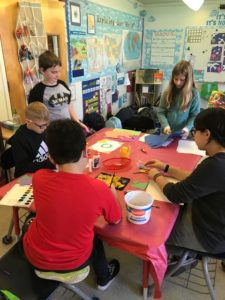 collages have been on the bulletin board at school. Our goals:
collages have been on the bulletin board at school. Our goals:
- Choose 3 different art styles to create 3 still life pictures
- Look at artwork by Henri Matisse, Pablo Picasso, Georgia O’Keefe, Jackson Pollock
- Use a variety of techniques to add color and texture
Veterans Day Heart Flags
As part of our Thanksgiving bulletin board, the students made red, white and blue heart “flags” to show their appreciation to all the Veterans who have served and are serving our country.
“Stars” by Sara Teasdale
We read this beautiful poem about the stars, to go along with the students’ Science Unit.
Have a wonderful Thanksgiving Holiday!











 Character Education
Character Education














 This week we continued learning about the Renaissance. Our objectives were:
This week we continued learning about the Renaissance. Our objectives were:
 Nutcracker Drawings
Nutcracker Drawings






















